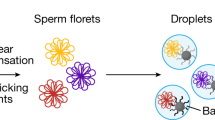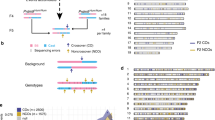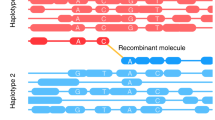Abstract
We have applied sperm DNA typing to determine the distribution of crossover events within a one megabase region of the short arm of human chromosome 4 near the locus for Huntington disease. A total of 29 recombinants were detected among 602 sperm typed after whole genome amplification. These recombinants were typed for seven polymorphic markers. The 280 kilobase D4S10–D4S126 interval was found to undergo recombination at a 6–9–fold greater rate per unit of physical distance than the adjacent 720 kb D4S126–D4S127 interval. Sperm typing has the potential to dissect mammalian recombination hot spots to the point where DNA sequence analysis may reveal the molecular basis for hyperrecombination.
This is a preview of subscription content, access via your institution
Access options
Subscribe to this journal
Receive 12 print issues and online access
$209.00 per year
only $17.42 per issue
Buy this article
- Purchase on Springer Link
- Instant access to full article PDF
Prices may be subject to local taxes which are calculated during checkout
Similar content being viewed by others
References
Donis-Keller, H. et al. A genetic linkage map of the human genome. Cell 51, 319–337 (1987).
Laurie, D.A. & Hulten, M.A. Further studies on chiasma distribution and interference in the human male. Ann. hum. Genet. 49, 203–214 (1985).
NIH/CEPH Collaborative Mapping Group A comprehensive genetic linkage map of the human genome. Science 258, 67–86 (1992).
Li, H. et al. Amplification and analysis of DNA sequences in single human sperm. Nature 335, 414–417 (1988).
Allitto, B.A. et al. Increased recombination adjacent to the Huntingdon disease-linked D4S10 marker. Genomics 9, 104–112 (1991).
Locke, R.A. et al. A genetic linkage map of the chromosome 4 short arm. Somat. Cell molec. Genet. 19, 95–101 (1993).
Zhang, L. et al. Whole genome amplification from a single cell: Implication for genetic analysis. Proc. natn. Acad. Sci. U.S.A. 89, 5847–5851 (1992).
Petes, T.D., Malone, R.E. and Smyington, L.S. . in The Molecular and Cellular Biology of the Yeast Saccharomyces (eds Broach, J., Jones, E.W. & Pringle, J.R.) 407–521 (Cold Spring Harbor Press, New York, 1991).
Bryda, E.C., Depart, J.A., Sant'Angelo, D.B., Murphy, D.B. & Passmore, H.C. Multiple sites of crossing over within the Eb recombinational hot spot in the mouse. Mamm. Genome 2, 123–129 (1992).
Henke, A., Fischer, C. & Rappold, G.A. Genetic map of the human pseudoautosomal region reveals a high rate of recombination in female meiosls at the Xp telomere. Genomics 18, 478–485 (1994).
Rouyer, F. et al. The pseudoautosomal region of the human sex chromosomes. Cold Spring Harbor Symp. Quant. Biol. 51, 221–228 (1986).
Page, D.C. et al. Linkage, physical mapping and DNA sequence analysis of pseudoautosomal loci on the human X and Y chromosomes. Genomics 1, 243–256 (1987).
Westphal, E.M. et al. Tyrosine aminotrasferase and chymotrypsinogen B are linked to haptoglogin on human chromosome 16q: Comparison of genetic and physical distances. Genomics 1, 313–319 (1987).
Bowcock, A.M. et al. High recombination between two physically close human basement membrane collagen genes at the distal end of chromosome 13q. Proc. natn. Acad. Sci. U.S.A. 85, 2701–2705 (1988).
Sefton, L., Kelsey, G., Kearney, P., Povery, S. & Wolfe, J. A physical map of the human PI and AACT genes. Genomics 7, 382–388 (1990).
Benger, J.C. et al. Localization and genetic linkage of the human immunoglobulin heavy chain genes and the creatine kinase brain (CKB) gene: identification of a hot spot for recombination. Genomics 9, 614–622 (1991).
Janson, M. et al. Detailed physical map of human chromosomal region 11q12–13 shows high meiotic recombination rate around the MEN1 locus. Proc. natn. Acad. Sci. U.S.A. 88, 10609–10613 (1991).
Shutler, G.G., MacKenzie, A.E. & Korneluk, R.G. The 1.5 Mb region spanning the myotonlc dystrophy locus shows uniform recombination frequency. Am. J. hum. Genet. 54, 104–113 (1994).
Oudet, C., Hanauer, A., Ciemens, P.I., Caskey, T. & Mendel, J.L. Two hot spots of recombination in the DMD gene correlate with the deletion prone regions. Hum. molec. Genet. 1, 599–603 (1992).
Hubert, R. et al. Sperm typing allows accurate measurement of the recombination fraction between D3S2 and D3S3 on the short arm of human chromosome 3. Genomics 12, 683–687 (1992).
McCombie, W.R. et al. Expressed genes, Alu repeats and polymorphisms in cosmids sequenced from chromosome 4p16.3. Nature Genet. 1, 348–353 (1992).
Cui, X. et al. Gene-centromere mapping by PCR analysis of individual oocytes. Genomics 13, 713–717 (1992).
Bates, G.P. et al. Characterization of a yeast artificial chromosome contig spanning the Huntingdon's disease gene candidate region. Nature Genet. 1, 180–187 (1992).
Zuo, J., Robbins, C., Taillon-Miller, P., Cox, D.R. & Myers, R.M. Cloning of the Huntington disease region in yeast artificial chromosomes. Hum. molec. Genet. 1, 149–159 (1992).
Baxendale, S. et al. A cosmid contig and high resolution restriction map of the 2 megabase region containing the Huntington's disease gene. Nature Genet. 4, 181–186 (1993).
Weber, H.I. & May, P.E. Abundant class of human DNA polymorphisms which can be typed using the polymerase chain reaction. Am. J. hum. Genet. 44, 388–396 (1989).
Litt, M. & Luty, J.A. A hypervariable microsatellite revealed by in vitro amplification of a dinucleotide repeat within the cardiac muscle actin gene. Am. J. hum. Genet. 44, 397–401 (1989).
Gusella, J.F. et al. A polymorphic DNA marker genetically linked to Huntington's disease. Nature 306, 234–238 (1983).
Stapleton, P.M. Sequence analysis of three polymorphic regions in the human genome detected by the G8 probe for RFLPs associated with Huntington's disease. Nucl. Acids Res. 16, 2735 (1988).
Li, H., Cui, X. & Arnheim, N. Analysis of DNA sequence variation in single ceils. Methods — a companion to Methods in Enzymology (ed. N. Arnheim) 2, 49–59 (Academic Press, 1991).
Cui, X. et al. Single sperm typing: determination of genetic distance between the G-gamma globin and parathyroid hormone loci. Proc. natn. Acad. Sci. U.S.A. 86, 9389–9393 (1989).
Hubert, R., Weber, J., Schmitt, K., Zhang, L. & Amheim, N. A New Source of polymorphic DNA markers for sperm typing: analysis of microsatellite repeats in single cells. Am. J. hum. Genet. 51, 985–991 (1992).
Author information
Authors and Affiliations
Rights and permissions
About this article
Cite this article
Hubert, R., MacDonald, M., Gusella, J. et al. High resolution localization of recombination hot spots using sperm typing. Nat Genet 7, 420–424 (1994). https://doi.org/10.1038/ng0794-420
Received:
Accepted:
Issue Date:
DOI: https://doi.org/10.1038/ng0794-420
This article is cited by
-
Genome-wide recombination map construction from single sperm sequencing in cattle
BMC Genomics (2022)
-
From molecules to populations: appreciating and estimating recombination rate variation
Nature Reviews Genetics (2020)
-
ARG-walker: inference of individual specific strengths of meiotic recombination hotspots by population genomics analysis
BMC Genomics (2015)
-
Dissecting genomic diversity, one cell at a time
Nature Methods (2014)
-
High-resolution linkage map for two honeybee chromosomes: the hotspot quest
Molecular Genetics and Genomics (2014)



